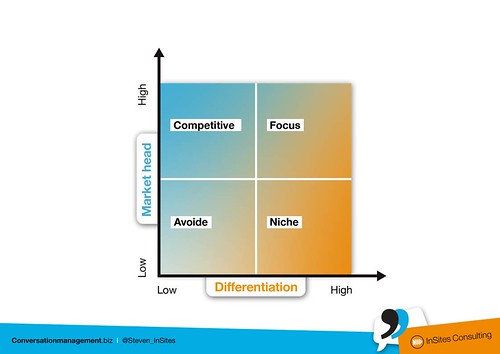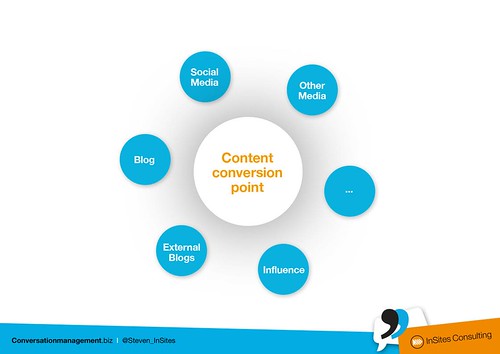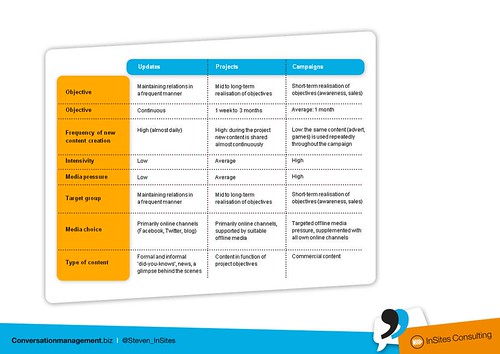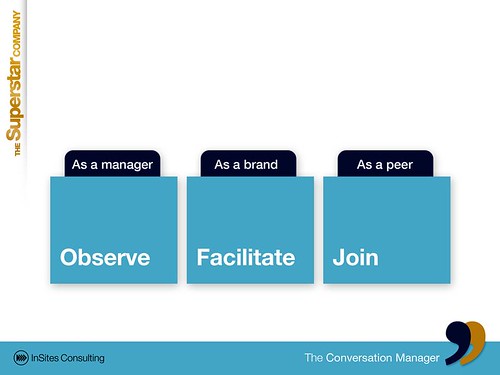Content Marketing in 6 steps


Step 1: Topic selection
The first must is to check which domains your company can offer unique content in. This content needs to be in line with the company culture & vision, obviously. As far as this choice is concerned it is sensible to check one’s own expertise on the one hand and on the other to see how unique one is in the market. Secondly you investigate the market’s needs. Find out what the topics are that your target group is looking for. A ‘netnographic’ survey or an extensive online search can help you discover these domains. Example: if you are working in a company which organises home care, you want to offer content about ailments your company has a lot of knowledge on, for which there is a lack of information, and that many people are looking for. This is the way to reach an interested audience. Combining the internal (level of uniqueness) and external (what people are looking for) dimensions will result in four categories:
- Avoid: making content your company is not unique in and there is not much demand for, is wasting time and money. 0% of your content should fall in this category.
- Competitive: making content the market is asking for, but your company is not unique in, is necessary once in a while. Given the major need of the market, you regularly respond to that. Do take into account that competitors will also write about these domains: therefore you limit your efforts. 25% of your content is in this category.
- Niche: not many people are interested in this content but it does differentiate your company in the market. Invest 15% of the content in this category.
- Focus: this content will help your company make the difference. The market is looking for it, but competitors are not offering satisfactory solutions. 60% of your content is focused on this category.
Step 2: Content conversion strategy
One of the content marketing targets is generating extra revenues. Hence the importance of creating a good plan in advance, which specifies how content can lead to conversion. The main question is to decide at which point conversion will happen. Then the art is to bring the reader to the content conversion point via the various “content placesâ€.
Here’s a familiar example: Rabobank edited a content conversion plan in their content planning for starter-starter-entrepreneurs. In order to offer advice to this target group, they created the content site www.ikgastarten.nl (www.imastarter.nl). Anyone impressed by the information on the site would end up on the Rabobank.nl website where the conversion takes place. Basically a conversion plan had best be compared with composing a football team. The ultimate target is to score, which means the ball has to get to the striker. Certain teams work with the long ball, and thus ensure the striker rapidly getting access to it.
Step 3: Content planning
After determining the topics the next step is to effectively plan the content. Three content levels can be used when doing so: content updates, content projects and content campaigns.
Updates
Updates are short messages sent with a given regularity. It is a combination of formal content (data, news, hiring…) and informal content (culture, messages on employees, backstage information). These are content pin-pricks which will keep the fans and followers informed of various important and less important matters. The updates are shared mainly via social media. They keep the memory of your company alive.
Projects
Projects are active over a longer period and concern a given theme. Example: a project could be a project launch, a new department, in important survey, a major customer event or a search for employees. As a company you regularly create content concerning the theme during a given period lasting anything between 1 week and 3 months. Projects strive after a clear target. The content is planned depending on this target. This information is mainly shared via online channels (regular smaller and bigger pin-pricks) and can be supported by offline media. A project can possibly also be supported by a campaign. Projects focus strongly on a clearly determined company aspect.
Campaigns
Campaigns are shorter but more intense than projects. Campaigns are often supported by offline media. This content creates an awareness of the company or is used to spread around important company news. All media are used to force a short-term result (usually renown and sales).
Step 4: Conversation-worthy content
Which content is conversation-worthy? That is the main question asked today by many social media and Internet experts. In order to answer that question, we organised a unique survey to prepare this paper. During the survey we gathered all conversations on about 1,000 Facebook fan pages of two hundred global brands. In total we analysed more than 770,000conversations about these brands. The same was done on Twitter: during a random week in June 2011 we analysed tweets concerning about 300 brands. This resulted in 246,000conversations. In order to gain insights into what people share with each other, we used data-mining (a complex, in-depth analysis of all available conversation and data) on a million brand conversations. The survey generated many details, but these are the main conclusions:
- The classics still do the trick: contests and games. Content with a game aspect, contests… It results in many a conversation. Together with interaction this gamification receives a lot of ‘likes’. The word ‘free’ still does a good job as well. When one can get something for free, this generates conversations. And this does not only concern free products, but also free content.
- Structural collaboration. Involve people in your decisions and they will talk about it. When their engagement rises, the number of conversations increases. This need not be complex. Asking a question to the fans can generate a lot of interaction. Furthermore consumers will show their enthusiasm by means of ‘likes’.
- Current events. Fans love sharing news about your company: consumers love to stay informed about news of their favourite companies. But wider topics are also conversation-worthy. Even if not concerning products directly, people love to talk about art, music, food, sports… and they show that they are interested by ‘liking’ this content.
- Positive messages. There is more interaction when sharing something positive than something negative. Consumers love positive stories. Positive messages also obtain a lot of e-‘likes’.
Step 5: Managing conversations
The moment content is shared widely amongst (potential) customers, it is recommended you actively participate in the conversation. That is where we use my first book’s approach (The Conversation Manager): observing, facilitating and participating.
- Observing: listen to the reactions to your content. Measure how many conversations are generated, what their sentiment is and how much impact they have.
- Facilitating: make the sharing of content easy. Add share buttons to everything; make as much digital content as possible. But facilitating does not stop there: it also implies building relations with opinion leaders in your sector. A good relation and strong content will ensure that opinion leaders will be happy to share your content with their network.
- Participating: participate actively in the conversations. If questions are asked, try and answer them as accurately as you can.
Step 6: Measuring success
Evidently it is very important to actively follow content efforts and to measure the impact they have. Determining targets largely depends on the objectives you have set yourself. Nonetheless we would recommend including three levels of success indicators in your measuring system:
- Success indicators with a direct impact on the company targets
- Success indicators with a direct impact on the marketing targets
- Success indicators linked to the conversations concerning your company
There you go, those are the six steps of our content marketing approach. As mentioned before this is based on the input from several market studies. All details can be read in this paper. Feel free to down load it in order to read everything at a later stage:
[slideshare id=11438613&doc=asixstepcontentmarketingmodel-120206005134-phpapp01]
I am obviously very interested in your experiences, feedback, suggestions. Content Marketing is a domain which gets a lot of (renewed) attention. We are all still learning, so feel free to share your experiences!



